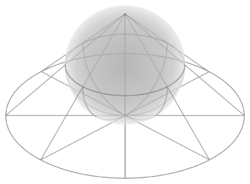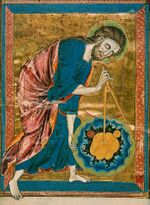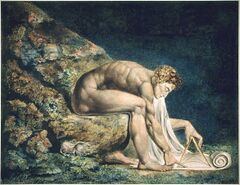List of geometers
Topic: Biography
 From HandWiki - Reading time: 5 min
From HandWiki - Reading time: 5 min
Short description: None

One of the oldest surviving fragments of Euclid's Elements, found at Oxyrhynchus and dated to c. 100 AD (P. Oxy. 29). The diagram accompanies Book II, Proposition 5.[1]
| Geometry |
|---|
 |
| Geometers |
A geometer is a mathematician whose area of study is geometry.
Some notable geometers and their main fields of work, chronologically listed, are:
1000 BCE to 1 BCE
- Baudhayana (fl. c. 800 BC) – Euclidean geometry
- Manava (c. 750 BC–690 BC) – Euclidean geometry
- Thales of Miletus (c. 624 BC – c. 546 BC) – Euclidean geometry
- Pythagoras (c. 570 BC – c. 495 BC) – Euclidean geometry, Pythagorean theorem
- Zeno of Elea (c. 490 BC – c. 430 BC) – Euclidean geometry
- Hippocrates of Chios (born c. 470 – 410 BC) – first systematically organized Stoicheia – Elements (geometry textbook)
- Mozi (c. 468 BC – c. 391 BC)
- Plato (427–347 BC)
- Theaetetus (c. 417 BC – 369 BC)
- Autolycus of Pitane (360–c. 290 BC) – astronomy, spherical geometry
- Euclid (fl. 300 BC) – Elements, Euclidean geometry (sometimes called the "father of geometry")
- Apollonius of Perga (c. 262 BC – c. 190 BC) – Euclidean geometry, conic sections
- Archimedes (c. 287 BC – c. 212 BC) – Euclidean geometry
- Eratosthenes (c. 276 BC – c. 195/194 BC) – Euclidean geometry
- Katyayana (c. 3rd century BC) – Euclidean geometry
1–1300 AD
- Hero of Alexandria (c. AD 10–70) – Euclidean geometry
- Pappus of Alexandria (c. AD 290–c. 350) – Euclidean geometry, projective geometry
- Hypatia of Alexandria (c. AD 370–c. 415) – Euclidean geometry
- Brahmagupta (597–668) – Euclidean geometry, cyclic quadrilaterals
- Vergilius of Salzburg (c.700–784) – Irish bishop of Aghaboe, Ossory and later Salzburg, Austria; antipodes, and astronomy
- Al-Abbās ibn Said al-Jawharī (c. 800–c. 860)
- Thabit ibn Qurra (826–901) – analytic geometry, non-Euclidean geometry, conic sections
- Abu'l-Wáfa (940–998) – spherical geometry, spherical triangles
- Alhazen (965–c. 1040)
- Omar Khayyam (1048–1131) – algebraic geometry, conic sections
- Ibn Maḍāʾ (1116–1196)
1301–1800 AD
 Leonardo da Vinci |
 Johannes Kepler |
 Girard Desargues |
 René Descartes |
 Blaise Pascal |
 Isaac Newton |
 Leonhard Euler |
 Carl Gauss |
 August Möbius |
 Nikolai Lobachevsky |
 John Playfair |
 Jakob Steiner |
- Piero della Francesca (1415–1492)
- Leonardo da Vinci (1452–1519) – Euclidean geometry
- Jyesthadeva (c. 1500 – c. 1610) – Euclidean geometry, cyclic quadrilaterals
- Marin Getaldić (1568–1626)
- Jacques-François Le Poivre (1652–1710), projective geometry
- Johannes Kepler (1571–1630) – (used geometric ideas in astronomical work)
- Edmund Gunter (1581–1686)
- Girard Desargues (1591–1661) – projective geometry; Desargues' theorem
- René Descartes (1596–1650) – invented the methodology of analytic geometry, also called Cartesian geometry after him
- Pierre de Fermat (1607–1665) – analytic geometry
- Blaise Pascal (1623–1662) – projective geometry
- Christiaan Huygens (1629–1695) – evolute
- Giordano Vitale (1633–1711)
- Philippe de La Hire (1640–1718) – projective geometry
- Isaac Newton (1642–1727) – 3rd-degree algebraic curve
- Giovanni Ceva (1647–1734) – Euclidean geometry
- Johann Jacob Heber (1666–1727) – surveyor and geometer
- Giovanni Gerolamo Saccheri (1667–1733) – non-Euclidean geometry
- Leonhard Euler (1707–1783)
- Tobias Mayer (1723–1762)
- Johann Heinrich Lambert (1728–1777) – non-Euclidean geometry
- Gaspard Monge (1746–1818) – descriptive geometry
- John Playfair (1748–1819) – Euclidean geometry
- Lazare Nicolas Marguerite Carnot (1753–1823) – projective geometry
- Joseph Diaz Gergonne (1771–1859) – projective geometry; Gergonne point
- Carl Friedrich Gauss (1777–1855) – Theorema Egregium
- Louis Poinsot (1777–1859)
- Siméon Denis Poisson (1781–1840)
- Jean-Victor Poncelet (1788–1867) – projective geometry
- Augustin-Louis Cauchy (1789–1857)
- August Ferdinand Möbius (1790–1868) – Euclidean geometry
- Nikolai Ivanovich Lobachevsky (1792–1856) – hyperbolic geometry, a non-Euclidean geometry
- Michel Chasles (1793–1880) – projective geometry
- Germinal Dandelin (1794–1847) – Dandelin spheres in conic sections
- Jakob Steiner (1796–1863) – champion of synthetic geometry methodology, projective geometry, Euclidean geometry
1801–1900 AD
 Julius Plücker |
 Arthur Cayley |
 Bernhard Riemann |
 Richard Dedekind |
 Max Noether |
 Felix Klein |
 Hermann Minkowski |
 Henri Poincaré |
 Evgraf Fedorov |
- Karl Wilhelm Feuerbach (1800–1834) – Euclidean geometry
- Julius Plücker (1801–1868)
- János Bolyai (1802–1860) – hyperbolic geometry, a non-Euclidean geometry
- Christian Heinrich von Nagel (1803–1882) – Euclidean geometry
- Johann Benedict Listing (1808–1882) – topology
- Hermann Günther Grassmann (1809–1877) – exterior algebra
- Ludwig Otto Hesse (1811–1874) – algebraic invariants and geometry
- Ludwig Schlafli (1814–1895) – Regular 4-polytope
- Pierre Ossian Bonnet (1819–1892) – differential geometry
- Arthur Cayley (1821–1895)
- Joseph Bertrand (1822–1900)
- Delfino Codazzi (1824–1873) – differential geometry
- Bernhard Riemann (1826–1866) – elliptic geometry (a non-Euclidean geometry) and Riemannian geometry
- Julius Wilhelm Richard Dedekind (1831–1916)
- Ludwig Burmester (1840–1927) – theory of linkages
- Edmund Hess (1843–1903)
- Albert Victor Bäcklund (1845–1922)
- Max Noether (1844–1921) – algebraic geometry
- Henri Brocard (1845–1922) – Brocard points
- William Kingdon Clifford (1845–1879) – geometric algebra
- Pieter Hendrik Schoute (1846–1923)
- Felix Klein (1849–1925)
- Sofia Vasilyevna Kovalevskaya (1850–1891)
- Evgraf Fedorov (1853–1919)
- Henri Poincaré (1854–1912)
- Luigi Bianchi (1856–1928) – differential geometry
- Alicia Boole Stott (1860–1940)
- Hermann Minkowski (1864–1909) – non-Euclidean geometry
- Henry Frederick Baker (1866–1956) – algebraic geometry
- Élie Cartan (1869–1951)
- Dmitri Egorov (1869–1931) – differential geometry
- Veniamin Kagan (1869–1953)
- Raoul Bricard (1870–1944) – descriptive geometry
- Ernst Steinitz (1871–1928) – Steinitz's theorem
- Marcel Grossmann (1878–1936)
- Oswald Veblen (1880–1960) – projective geometry, differential geometry
- Nathan Altshiller Court (1881–1968), author of College Geometry
- Emmy Noether (1882–1935) – algebraic topology
- Harry Clinton Gossard (1884–1954)
- Arthur Rosenthal (1887–1959)
- Helmut Hasse (1898–1979) – algebraic geometry
1901–present
H. S. M. Coxeter |
 Ernst Witt |
 Benoit Mandelbrot |
 Branko Grünbaum |
 Michael Atiyah |
 J. H. Conway |
 William Thurston |
 Mikhail Gromov |
 George W. Hart |
 Shing-Tung Yau |
 Károly Bezdek |
 Grigori Perelman |
 Denis Auroux |
- William Vallance Douglas Hodge (1903–1975)
- Patrick du Val (1903–1987)
- Beniamino Segre (1903–1977) – combinatorial geometry
- J. C. P. Miller (1906–1981)
- André Weil (1906–1998) – Algebraic geometry
- H. S. M. Coxeter (1907–2003) – theory of polytopes, non-Euclidean geometry, projective geometry
- J. A. Todd (1908–1994)
- Daniel Pedoe (1910–1998)
- Shiing-Shen Chern (1911–2004) – differential geometry
- Ernst Witt (1911–1991)
- Rafael Artzy (1912–2006)
- Aleksandr Danilovich Aleksandrov (1912–1999)
- László Fejes Tóth (1915–2005)
- Edwin Evariste Moise (1918–1998)
- Aleksei Pogorelov (1919–2002) – differential geometry
- Magnus Wenninger (1919–2017) – polyhedron models
- Jean-Louis Koszul (1921–2018)
- Isaak Yaglom (1921–1988)
- Eugenio Calabi (1923–2023)
- Benoit Mandelbrot (1924–2010) – fractal geometry
- Katsumi Nomizu (1924–2008) – affine differential geometry
- Michael S. Longuet-Higgins (1925–2016)
- John Leech (1926–1992)
- Alexander Grothendieck (1928–2014) – algebraic geometry
- Branko Grünbaum (1929–2018) – discrete geometry
- Michael Atiyah (1929–2019)
- Lev Semenovich Pontryagin (1908–1988)
- Geoffrey Colin Shephard (1927–2016)
- Norman W. Johnson (1930–2017)
- John Milnor (1931–)
- Roger Penrose (1931–)
- Yuri Manin (1937–2023) – algebraic geometry and diophantine geometry
- Vladimir Arnold (1937–2010) – algebraic geometry
- Ernest Vinberg (1937–2020)
- J. H. Conway (1937–2020) – sphere packing, recreational geometry
- Robin Hartshorne (1938–) – geometry, algebraic geometry
- Phillip Griffiths (1938–) – algebraic geometry, differential geometry
- Enrico Bombieri (1940–) – algebraic geometry
- Robert Williams (1942–)
- Peter McMullen (1942–)
- Richard S. Hamilton (1943–) – differential geometry, Ricci flow, Poincaré conjecture
- Mikhail Gromov (1943–)
- Rudy Rucker (1946–)
- William Thurston (1946–2012)
- Shing-Tung Yau (1949–)
- Michael Freedman (1951–)
- Egon Schulte (1955–) – polytopes
- George W. Hart (1955–) – sculptor
- Károly Bezdek (1955–) – discrete geometry, sphere packing, Euclidean geometry, non-Euclidean geometry
- Simon Donaldson (1957–)
- Kenji Fukaya (1959–) – symplectic geometry
- Oh Yong-Geun (1961–)
- Toshiyuki Kobayashi (1962–)
- Hiraku Nakajima (1962–) – representation theory and geometry
- Hwang Jun-Muk (1963–) – algebraic geometry, differential geometry
- Grigori Perelman (1966–) – Poincaré conjecture
- Maryam Mirzakhani (1977–2017)
- Denis Auroux (1977–)
Geometers in art
 God as architect of the world, 1220–1230, from Bible moralisée |
 Kepler's Platonic solid model of planetary spacing in the Solar System from Mysterium Cosmographicum (1596) |
 The Ancient of Days, 1794, by William Blake, with the compass as a symbol for divine order |
 Newton (1795), by William Blake; here, Newton is depicted critically as a "divine geometer".[2] |
See also
- Mathematics and architecture
References
- ↑ Bill Casselman. "One of the Oldest Extant Diagrams from Euclid". University of British Columbia. https://www.math.ubc.ca/~cass/Euclid/papyrus/papyrus.html.
- ↑ "Newton, object 1 (Butlin 306) "Newton"". William Blake Archive. September 25, 2013. http://www.blakearchive.org/exist/blake/archive/copyinfo.xq?copyid=but306.1.
 |
Licensed under CC BY-SA 3.0 | Source: https://handwiki.org/wiki/Biography:List_of_geometers49 views | Status: cached on July 17 2024 03:09:19↧ Download this article as ZWI file
 KSF
KSF